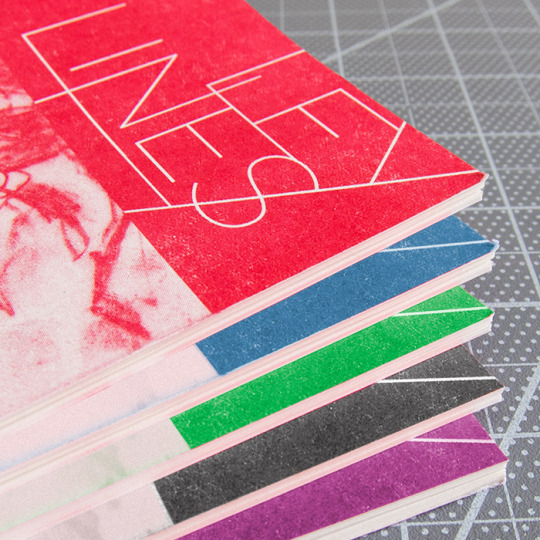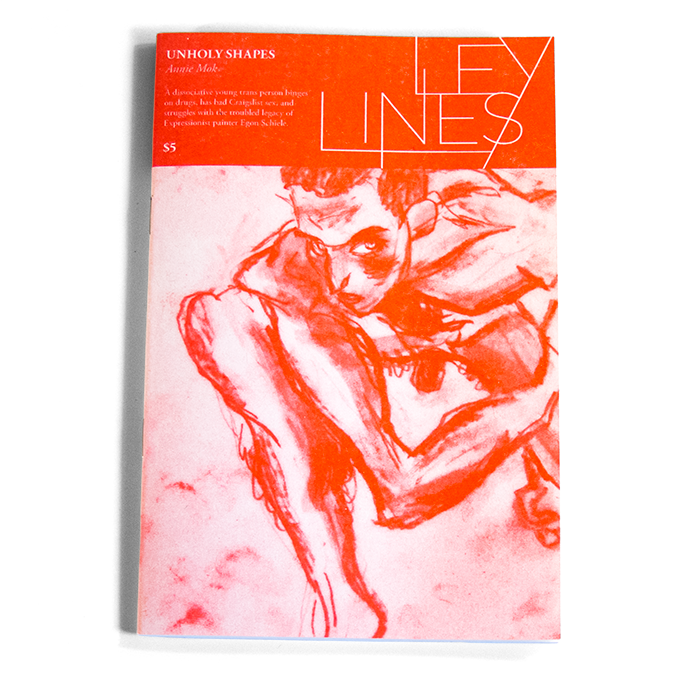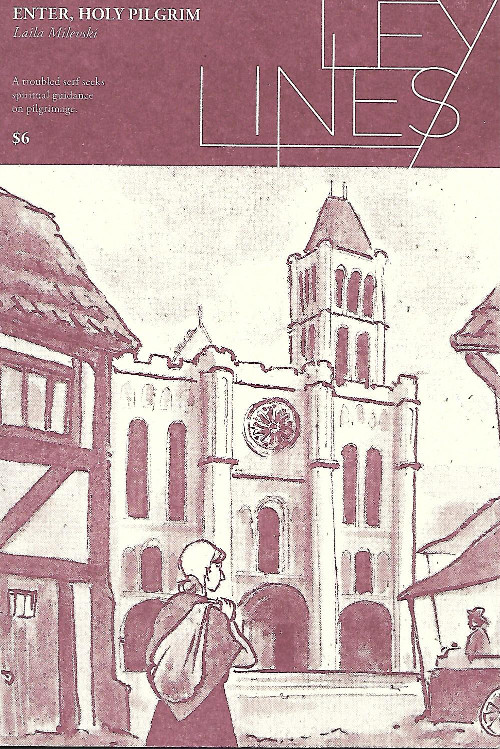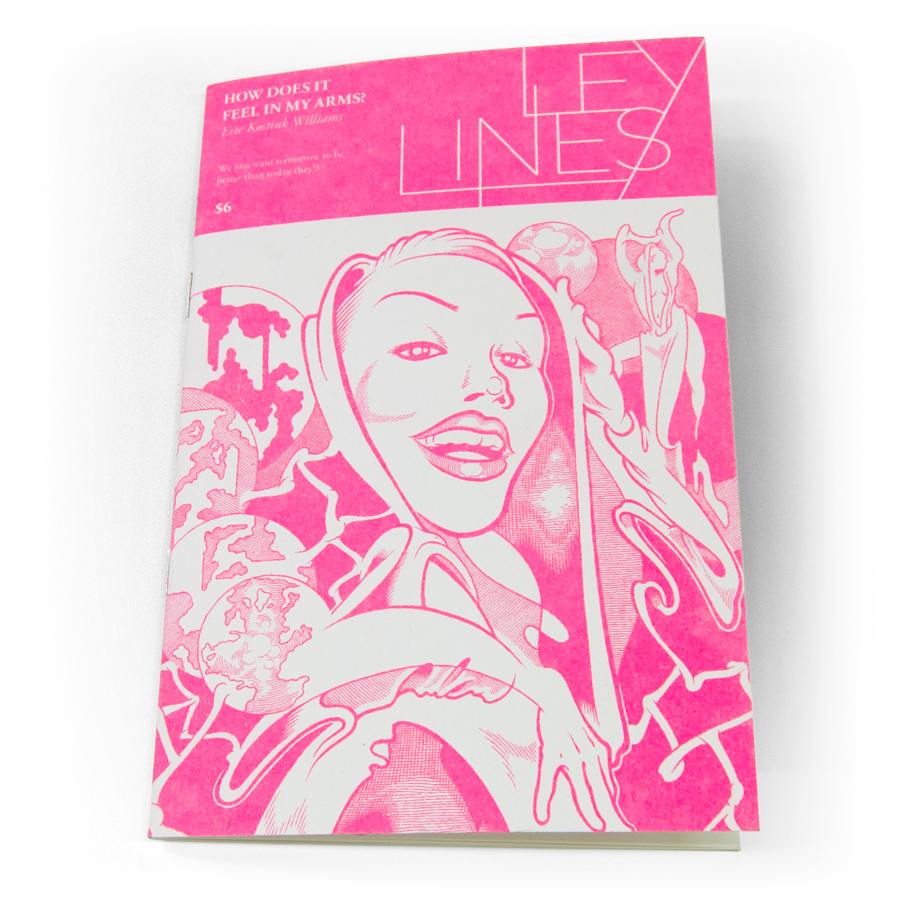Hi readers. As part of this week’s Ley Lines coverage, I sat down with publishers and cartoonists L Nichols and Kevin Czap. Together as Grindstone Comics and Czap Books, they have been publishing Ley Lines since 2014. I did an interview with them in 2015 about the series, and I sat back down with them in May to talk again. This interview was conducted over Skype, and was lightly edited for clarity and flow.
You can find the original interview here.
Ley Lines Beginnings
Alex Hoffman: I wanted to start off by asking you both to recap for readers; how did the Ley Lines project come together?
L Nichols: My memory is that I harassed Kevin until they agreed to do it. I had a professor in college who studied fan culture and in class one day he asked, “Why doesn’t fine art have fans?”

Kevin Czap: Is this the famous Henry Jenkins?
L Nichols: Yeah. And just that one comment always stuck with me and I was like, why doesn’t it? But it kinda does, artists are fans of other artists. Maybe it’s not always so obvious, but our work is changed by other people’s work. So, that kind of stuck around in my head for a while and I would always chat with Kevin about this at conventions.
Kevin Czap: And at one point many years ago we shared a blog with Darryl Ayo called the Comix Cube and one of the recurring themes of the writing was different kinds of influence on comics that we were making or that other people were making. L & I both have art backrounds in different ways. We both had an interest in art and comics, and we would talk a lot on the internet and we had this idea. We both agreed it was a good idea, and then at one point L was like, “Well, we’ve got Annie Mok on board and we’re going to put this out.” And I wasn’t totally ready, but L already had a printer lined up, so I kind of got dragged into it. It was something I wanted to do but it was at a time when I was having trouble managing my obligations. I’m glad that this project stuck it out.
L Nichols: I tend to dive into things.
Alex Hoffman: I’ve noticed that.
L Nichols: I’m a fan of committing to a project and then seeing what happens. This year is my 10th wedding anniversary. We got engaged after dating after 5 weeks. I dive into commitment.
Alex Hoffman: The first issue of Ley Lines came out in 2015?
Kevin Czap: 2014, in November.
Alex Hoffman: Right, that’s right. It was part of the 2015 season. I remember getting it at GenghisCon that fall.
L Nichols: I know we had it for CAB.
Kevin Czap: Yeah, that was the debut. Annie was there too; Annie Mok did the first Ley Lines based on Egon Schiele. I think this happened later, or maybe it was the same year, but there was a Schiele exhibition happening in New York concurrently so that was nice.

Alex Hoffman: So that first book comes out; was the quarterly publication was the original plan, or did things develop as it went?
L Nichols: I think that was our response to Kevin’s feeling and my knowledge that I should be reasonable with what can be accomplished.
Alex Hoffman: So you wanted more!
L Nichols: I would always like more! But I think four a year is nice because it’s a reasonable publication schedule and we can manage it with our other projects. It’s a very specific type of comic and I feel like having a ton of them out at one time is too much.
Kevin Czap: The format was kind of inspired by other kinds of monograph series that L is more familiar with than I would be, but I remember having those talks early on.
L Nichols: Yeah.
Alex Hoffman: When you talk about monograph series that you’re riffing off of, do you have any specific titles you can remember?
L Nichols: I wish I could. There was this series of photograph zines. I really liked how they were all different but they were held together by the design of the book. That informed the way we laid out the covers so that they can all be very different but all be tied together as a series.
Alex Hoffman: That’s a good point. The comics in Ley Lines are even very structurally different from one another, but it’s that design that gives you a visual clue that these are all part of a collection.
L Nichols: By doing that, I wanted the artist to do whatever it was they were going to do without worrying about what the rest of the artists in the series have done. I don’t think it’s fair to ask someone to do something for my project completely not in a style you’re comfortable with. We’re already asking a lot from them. I don’t want them to have to worry about cohesion.
Kevin Czap: Since it’s not really a lucrative gig for [the artists involved], it’s like making it as much of an opportunity for them to do something they want to do as possible. That makes sense rather than, “Here’s my project, I need you to make something for it, and you don’t get anything out of it.” That’s not fair, it feels off putting, and that’s not what this is about.
L Nichols: Our intention is the excitement, that connection that an artist feels to another artist. Whatever the person who is making the Ley Lines is doing, I want it to be their personal reaction and for me, staying out of it as much as possible is important.
Kevin Czap: And it’s been nice so far. The majority if not all of the artists so far have been very proud of what they’ve put in and I think some of it is some of their best work, so it’s rewarding for all parties involved.
Alex Hoffman: There were a couple of things that came up in there that were interesting to me. The first is when you talk about the finances. I’m always fascinated by how these kinds of projects get made. Could you talk about the relationship you have as publishers with Annie Koyama of Koyama Press? I understand that the series is being sponsored, or being published in conjunction with Koyama Press. Could you explain how that relationship works?
Kevin Czap: To be accurate, it’s financed, not copublished or sponsored. L & I did the first five issues. We both know Annie Koyama and love her, she’s one of the greatest people. She was a fan of the series and talked to us. She asked us to write her a proposal and so for the past two years, she has given us money to continue the series, which is a lovely thing to come from doing a thing you’re proud of. So essentially she gave us money and told us to keep doing what you’re doing. It wasn’t going to make this a Koyama branded thing. Just put a line in there that Koyama helped you out. And I think that might not have been a requirement, but we felt it was important.
Alex Hoffman: So it’s more like a grant.
L Nichols: Yeah.
Kevin Czap: Or a patronage, if you want to go the art route.
L Nichols: I’m very grateful that Annie has been as generous as she has been, because one of the reasons I wanted to do something like this is that these are the type of comics I want to see more of. I feel like her supporting it validates that feeling.
Discussing Laila Milevski’s Enter, Holy Pilgrim

Alex Hoffman: This interview really stemmed from a desire to write a review of Laila Milevski’s Enter, Holy Pilgrim.
Kevin Czap: Laila is a very thoughtful, interesting cartoonist. L brought her work to my attention.
L Nichols: I really liked that Drawing Antonioni book she did, and I think it was at RIPE a few years ago when I asked her if she would do one of these books. And she was like sure – can it be about architecture? And I was like, of course!
Alex Hoffman: One of the things that struck me about my discussion with Laila was about spirituality. Laila is an atheist, and I asked her what she felt it meant that she had spiritual experiences in places specifically designed to create those experiences.
Kevin Czap: I think that is a testament to how powerful art can be, which is an underlying theme of the whole series. I always describe Enter, Holy Pilgrim to people at shows as capturing the experience of witnessing something for the first time that should be impossible. It’s hard to imagine that kind of experience unless you are there in person. It’s a very beautiful comic.
Planning and Editing the Ley Lines Series
Alex Hoffman: When you ask people to be a part of Ley Lines, what’s your process? Are you doing more structured planning, or is it more serendipitous?
Kevin Czap: I think it’s kind of a mix. When we first started, we had a list of people we were interested in approaching. You want a cartoonist who has some interest in other art, like painting. And then when they started coming out, people would come up to us and express interest in doing an issue. Tommi Parrish was one of the first who did that. Which was a nice coincidence because I had just become familiar with and a fan of their work.
L Nichols: I agree it’s a mix. There are people who I’ve convinced (L and K laugh), like Andrew White, who I always talk to at conventions. And because of his curiosity he started looking more at art in the process of me convincing him to participate.
Alex Hoffman: That’s interesting, and I wonder if that’s true for all readers in the series? Do you think that because these comics exist more comics people are engaging with these other forms of art?
L Nichols: That’s my hope and dream.
Kevin Czap: I think so. The Ley Lines comic I did was centered around the performance artist Bas Jan Ader, a person that not a lot of people know that much about but whom I’m really fascinated by. I hope that this puts him on people’s radar so it’s enough information that people can say they’ve heard of him before. That’s why I included a work’s cited page.
L Nichols: Yeah, your comic made me go look him up.
Alex Hoffman: For me this has been a resounding theme of the series. As a reader, these comics are lovely or good comics by themselves, but they exist in this interesting space where they capture the ephemera of that artist’s body of work or that place or that feeling, but they exist in a separate place.
Kevin Czap: Yeah.
Alex Hoffman: Looking at that original art or concept, and then seeing how the cartoonist interacts with that work has been especially rewarding for me. One of the things I’ve noticed is that through this series I have evaluated my own reaction to the cross-material in relationship to the comics in Ley Lines. There’s a fascinating intersection of the reader’s reaction to the source material and the cartoonist’s reaction to the source material that I find fascinating.
L Nichols: I think that the more lines that can be drawn between things, the better.
Alex Hoffman: There’s also this really interesting three-way conversation you’re having in the Ley Lines series. The reader is having a conversation with the cartoonist, but also through their work, you have a relationship with this other artist or art form. I wonder what your thoughts are about that.
Kevin Czap: I do think there are some interesting levels baked into the series prompt as it exists. Those conversations between the different people; the subject, the artist, the reader. But also the interesting play between the work that’s engaging with the subject matter and how one informs the other. It’s a fertile field.
Alex Hoffman: And I think that as the medium matures there’s bound to be more cross pollination. Where do you think Ley Lines falls in this idea of cross pollination?
Kevin Czap: We definitely intend to accelerate that cross pollination.
Alex Hoffman: Do you do much editing on the series? Or is it more a curatorial approach, where the edits are more based on where a specific comic falls in the schedule?
L Nichols: We do copy editing, but I would say we are pretty hands off. I trust the artists we ask to make the books. We wouldn’t ask them if we didn’t believe in them and their work. The thing I care about the most is that the artist who is creating the issue is choosing something that is personally meaningful for them. I want to see the personal connection to art, and give that connection a place to be present. Some cartoonists ask for feedback-
Kevin Czap: But we turn them down. (L laughs)
Alex Hoffman: I think that speaks to the transcendence of the concept. It seems like many if not all of the Ley Lines books are excellent, and I don’t use that word lightly. I wonder if it is that personal investment in that relationship between the art and the cartoonist that makes it so powerful.
Kevin Czap: I think that’s true, but also we’re asking really excellent artists to do this series. You can’t really lose with these people. We ferry it through the printing process and let them work.
Alex Hoffman: On some level I agree, but even great cartoonists can still make bad comics. I think you make great work when you are engaged with it. I think these comics give their artists a chance to be engaged.
L Nichols: Yeah.
Alex Hoffman: How well has the series been received, in your view? Is it doing the things you want it to do?
Kevin Czap: At the base level it’s facilitated some outstanding work. It’s hard to gauge how well it is working to accelerate the cross pollination of art and comics. The one thing that we’ve really noticed concretely is the positive reaction to the work. People are taking notice.
L Nichols: The thing that’s important to me isn’t people taking notice, but how genuine the reactions to the comics seem to be. That’s what I care about the most; really getting someone in a way they weren’t expecting. A lot of the people I’ve ended up talking to about Ley Lines have seemed to be touched in very personal ways. The feedback always seems personal and positive.
Alex Hoffman: Do you have people approach you at shows about the artists and art featured in Ley Lines?
L Nichols: I feel like I get more comics artists coming up to me saying that they read the book, and they tell me what their inspirations are.
Kevin Czap: I think there’s more of that conversation online rather than in person. The reviews of the books will have that. I think I get more feedback on Ley Lines as a series.
Alex Hoffman: Do you think there’s a way to make a project like this work the other way around. Sometimes it feels like Ley Lines brings comics closer to other types of art. Is there some way to bring those other types of art closer to comics?
L Nichols: I would really like to see Ley Lines at things that are not comics events. I’m working on that.
Alex Hoffman: So when the Van Gogh exhibition rolls through town, having copies of Ley Lines in the gift shop.
L Nichols: Sure. Part of the reason for calling the series Ley Lines is to bring different types of art onto the same playing field. Where comics and the other art both come from a place of power.
Kevin Czap: I was just in Toronto and I went to the Art Gallery of Ontario. In the gift shop, there was a copy of Wendy 2, again from Koyama. It’s not a preposterous concept to have Ley Lines at art gift shops. It’s just a matter of getting them there. I think part of the problem is that you get so entrenched in comics. You have these cow paths you make and follow.
Final Thoughts
Alex Hoffman: Do you think you will have more comics that engage with arts that are nonvisual? What is coming up next?

Kevin Czap: Well, we don’t tell artists what to create, but three of the four books this year are influenced by music in some way. Eric Kostiuk William’s is more explicitly about Kylie Minogue, Tommi’s issue has Lydia Lunch as an influence, and our next issue in August, by Shreyas R Krishnan, is about Abida Parveen, who is a sufi singer. When she pitched the idea, this was something I knew nothing about, which was a great opportunity to look into her work.
Shreyas is a younger cartoonist coming out of MICA a few years ago, so it’s kind of an honor to have her on the roster and being a part of her rising career.
We have Evan Dahm as the final cartoonist of the season. He’s well known as a web cartoonist. It’s nice to have cartoonists from multiple ends of the discipline participate, it’s not just a specific kind of cartoonist involved.
Alex Hoffman: What changes or improvements do you think Ley Lines needs?
Kevin Czap: The one thing I want to keep a mind to moving forward is thinking carefully about the kinds of artists we talk to about doing issues. We want each issue to be very different. We want to make sure that the cartoonists we ask and the artists they want to feature aren’t repetitive stylistically or personally.
L Nichols: I wish there was more diversity in the artists that are featured in Ley Lines. But I’m so happy with the series as a whole. It’s better than I could ever imagine.
Kevin Czap: I would second that.
